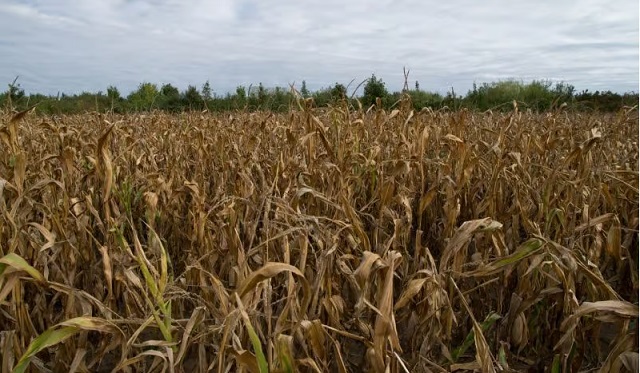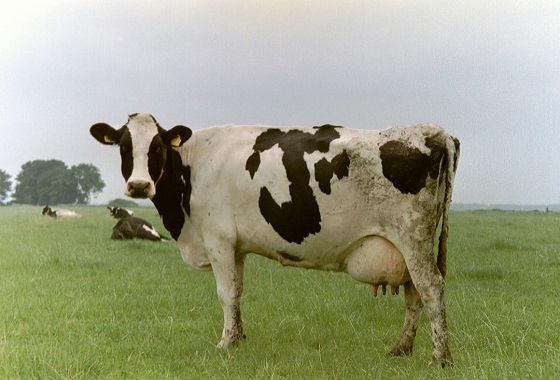Agriculture
The Enemies of Food Freedom

From the Brownstone Institute
By
In every war, there is necessarily an enemy force, and the war on our food supply is no exception.
My previous article addressed the ongoing attacks on farmers across the globe. In today’s article, we will look at some of the culprits behind this agenda. For anyone who delved into the entities behind the tyrannical Covid policies, many names on the list below will seem quite familiar.
Bayer/Monsanto
Bayer merged with Monsanto in 2018, combining the companies responsible for Agent Orange and pioneering chemical warfare. In 1999, Monsanto’s CEO Robert Shapiro bragged that the company planned to control “three of the largest industries in the world—agriculture, food, and health—that now operate as separate businesses. But there are a set of changes that will lead to their integration.” Today these chemical manufacturers control a huge percentage of the world’s food supply.
Cargill and the US Department of Agriculture (USDA)
Cargill is a World Economic Forum partner and the largest private company in the United States. This behemoth monopolizes unimaginably vast swaths of the global food industry, including meat processing in the United States. Cargill’s business practices, along with bigger-is-better policies enforced by their cronies at the United States Department of Agriculture, have led to the closures of many local abattoirs which forced farmers to depend on a few corporate mega-slaughterhouses. This leaves farmers waiting 14 months or longer for butchering slots, for which they often must transport their animals hundreds of miles—indeed, farmers and ranchers must book processing dates up to a year before the animal is even born. The high fees charged by Cargill’s slaughterhouses contribute to the skyrocketing price of meat—all while the farmers themselves are barely paid enough to cover the cost of raising the livestock. The USDA, meanwhile, makes sure their policies prevent farmers from processing meat themselves on their own farms.
Wellcome Trust
The Wellcome Trust, the former owner of Glaxo before it merged with SmithKline, played a major role in Britain’s Covid debacle and is unapologetic about its goal of reducing your food sovereignty. Wellcome Trust funds Livestock, Environment and People (LEAP), an organization dedicated to developing and testing behavioral modifications to coerce the public into removing meat and dairy from their diets. LEAP’s co-director Susan Jeffs bemoans that motivating people with environmental impact labels on their foods does not seem to work: “People are already settled into very established habits” and suggests instead altering what the industry provides, thereby forcing consumer choice. Wellcome Trust researchers recommend “availability interventions” that “rely less on individual agency” to reduce access to animal food products. Researcher Rachel Pechey opines that “meat taxes show a promising evidence for effectiveness but have been less acceptable in survey work…we don’t want to just go for the most acceptable [solutions].”
The World Health Organization
Dr. Tedros Adhanom Ghebreyesus, the WHO’s Director-General, would like you to believe that food production is responsible for almost one-third of the global burden of disease. He calls for transforming the global food system toward plant-based foods, reducing meat and dairy in our intake, and enforcing policies to save the climate through restricting diet. A WHO 2022 report concluded that “considerable evidence supports shifting populations towards healthful plant-based diets that reduce or eliminate intake of animal products.”
World Economic Forum
You are likely familiar with the World Economic Forum and their Great Reset agenda. Visit their webpage and treat yourself to such morsels as 5 reasons why eating insects could reduce climate change, why we need to give insects the role they deserve in our food systems, and why we might be eating insects soon. Suffice it to say that their plans for your dietary future are clear.
EAT Forum, the Lancet, and their Big Tech and Big Chemical Partners
The EAT Forum is “dedicated to transforming our global food system through sound science, impatient disruption and novel partnerships.” It was co-founded by the aforementioned Wellcome Trust, the Strawberry Foundation, and the Stockholm Resilience Centre. Their FRESH initiative—Food Reform for Sustainability and Health—aims to transform the global food system. Partners in the FRESH initiative include Google, Cargill, Syngenta, Unilever, Pepsico, and many chemical processors such as BASF, Bayer, and DuPont—a rather odd cast of characters for developing a healthy and sustainable dietary plan. EAT’s Shifting Urban Diets Initiative advocates for cities to adopt the Lancet-endorsed Planetary Health Diet, in which plant-based proteins are set to replace meat and dairy. Red meat is limited to 30 calories per day. A report drafted by EAT found that the transformation they want to foist upon our diets is “unlikely to be successful if left up to the individual,” and “require(s) reframing at the systemic level with hard policy interventions that include laws, fiscal measures, subsidies and penalties, trade reconfiguration and other economic and structural measures.”
The Rockefeller Foundation
Members of the Rockefeller family may carry more blame than anyone else in history for turning agriculture away from independent family farms towards corporate conglomerates.
In 1947, Nelson Rockefeller founded the International Basic Economy Corporation to modernize and corporatize agriculture in South America, particularly in Brazil and Venezuela. IBEC transformed farming to depend on expensive machinery and inputs that priced subsistence peasant farmers out of viability. The American International Association for Economic and Social Development (AIA), a Rockefeller-funded philanthropic organization, helped build the market through which IBEC could enrich its owners. While IBEC’s promotional literature claimed that the company was generously assisting the Third World by providing necessary consumer products while turning a profit, on closer examination, it was simply a business enterprise built on the Rockefellers’ old Standard Oil model, in which smaller competitors are forced out using monopolistic practices before prices are raised.
This tactic was taken to a whole new level with the so-called Green Revolution, first in Mexico in the 1940s, then in the Philippines and India in the 1960s, as well as in the United States. Traditional farming practices such as the use of manure as fertilizer for heirloom native crops were replaced with a model of mechanized chemical farming, using Rockefeller-funded new seed varieties which had been developed to require petrochemical fertilizers and pesticides to produce significantly increased crop yields compared to the traditional crops grown by peasant farmers in these countries.
It is worth noting that the Rockefellers, as oil oligarchs, stood to profit handsomely from the petroleum-based fertilizers and pesticides that this new method demanded. The crops grown were almost all cereal crops like rice and replaced more nutrient-dense, traditional crops like millet. India experienced an increase in food but a decrease in nutrition: with more empty calories but fewer fruits, vegetables, and animal proteins, micronutrients disappeared from the diet. Anemia, blindness, fertility problems, low birth weight, and immune impairment increased.
While the Green Revolution was hailed as the solution to world hunger and poverty, it also poisoned local water supplies, depleted the soil, and left farmers drowning in debt as they could no longer independently produce the fertilizer and seeds they needed. Informed readers can see how the later Monsanto GMO Roundup-Ready seed model followed this playbook established by the Rockefellers.
In 2006, the Rockefeller Foundation, Bill Gates, and others pushed the Alliance for a Green Revolution in Africa, or AGRA, and they again followed this proven playbook. Since AGRA’s launch, African biodiversity has been lost, and the number of severely undernourished people in sub-Saharan Africa has increased by nearly 50 percent, even by the UN’s own reports. Just as in India, farmers are being tricked into abandoning nutrient-dense, drought-resistant crops like heirloom millet in exchange for the empty calories of GMO corn. Hundreds of African organizations have demanded that this neocolonial project end, leaving the future of African agriculture in the hands of the native farmers who know the land best.
Now the Rockefeller Foundation has set its sights on the US food system with its Reset the Table agenda, handily launched in 2020 just weeks after the Great Reset was announced. Under rosy language calling for inclusivity and equity, the report states that “success will require numerous changes to policies, practices, and norms.” This includes a major focus on data collection and objectives that align closely with the One Health Agenda—more on that in a future article.
Bill Gates and the Gates Foundation
Bill Gates has followed the Rockefeller playbook for fumigating his fortune and transforming his image—while building more wealth—through the cynical ploy of philanthrocapitalism.
His fingers are deep in every public health pie, and his influence is nearly equal in the food wars. Besides financing the development of fake meats, he is behind the aforementioned AGRA program, is investing in geoengineering programs to dim the sun, and as of January 2021, owned 242,000 acres of prime US farmland, making him the largest private owner of farmland in the US. It is disconcerting to think that a man who believes we should phase out real meat controls so much of the method of production.
USAID and BIFAD
Another organization pushing you to eat bugs is USAID. This may surprise some of you who think of USAID as an organization dedicated to helping third-world countries, rather than as a longtime Trojan horse for CIA operations. (Skeptical of that claim? Go down the rabbit hole here and here and here and here.) Their Board for International Food and Agricultural Development, known as BIFAD, released a report titled “Systemic Solutions for Climate Change Adaptation and Mitigation.” This report calls for a complete transformation of the food supply and global agriculture. They propose to do this through ESG scores, carbon tracking, and eating insects.
So how do these organizations manage to push their agenda on the global population? We will cover that in a future article.
Agriculture
Federal cabinet calls for Canadian bank used primarily by white farmers to be more diverse

From LifeSiteNews
A finance department review suggested women, youth, Indigenous, LGBTQ, Black and racialized entrepreneurs are underserved by Farm Credit Canada.
The Cabinet of Prime Minister Mark Carney said in a note that a Canadian Crown bank mostly used by farmers is too “white” and not diverse enough in its lending to “traditionally underrepresented groups” such as LGBT minorities.
Farm Credit Canada Regina, in Saskatchewan, is used by thousands of farmers, yet federal cabinet overseers claim its loan portfolio needs greater diversity.
The finance department note, which aims to make amendments to the Farm Credit Canada Act, claims that agriculture is “predominantly older white men.”
Proposed changes to the Act mean the government will mandate “regular legislative reviews to ensure alignment with the needs of the agriculture and agri-food sector.”
“Farm operators are predominantly older white men and farm families tend to have higher average incomes compared to all Canadians,” the note reads.
“Traditionally underrepresented groups such as women, youth, Indigenous, LGBTQ, and Black and racialized entrepreneurs may particularly benefit from regular legislative reviews to better enable Farm Credit Canada to align its activities with their specific needs.”
The text includes no legal amendment, and the finance department did not say why it was brought forward or who asked for the changes.
Canadian census data shows that there are only 590,710 farmers and their families, a number that keeps going down. The average farmer is a 55-year-old male and predominantly Christian, either Catholic or from the United Church.
Data shows that 6.9 percent of farmers are immigrants, with about 3.7 percent being “from racialized groups.”
National census data from 2021 indicates that about four percent of Canadians say they are LGBT; however, those who are farmers is not stated.
Historically, most farmers in Canada are multi-generational descendants of Christian/Catholic Europeans who came to Canada in the mid to late 1800s, mainly from the United Kingdom, Ireland, Ukraine, Russia, Italy, Poland, the Netherlands, Germany, and France.
Agriculture
Bovaer Backlash Update: Danish Farmers Get Green Light to Opt Out as UK Arla Trial Abruptly Ends!

In a pivotal shift, Denmark’s Veterinary and Food Administration has issued new guidance: Farmers can immediately suspend Bovaer administration if they “suspect” it poses risks to herd health. On the heels of the Danish announcement—the major UK trial of Bovaer on 30 Arla Foods farms has abruptly ended amid health fears.
The Mandate Cracks: Farmers Given the Green Light to Opt Out
On November 5, 2025, Denmark’s Fødevarestyrelsen (Danish Veterinary and Food Administration) issued a press release and accompanying guidance clarified that farmers (specifically the herd manager, or besætningsansvarlige) could immediately exempt individual cows or entire herds from the mandatory Bovaer use if they suspected it was causing or exacerbating health issues, prioritizing animal welfare under existing regulations.
Sonia Elijah investigates is a reader-supported publication.
To receive new posts and support my work, consider becoming a free or paid subscriber.
This was in response to surging reports of cow illnesses since October 1, where farms with over 50 cows have been mandated to use the synthetic additive, Bovaer (containing 3-nitrooxypropanol), developed by DSM-Firmenich. If the farms do not comply, they face heavy fines.
Bovaer Backlash: Danish Cows Collapsing Under Mandatory Methane-Reducing Additive |
||||||
|
||||||
| Article updated: November 4 | ||||||
|
The guidance emphasized that exemptions apply to cases of feed-related metabolic disorders (e.g., fatty liver, milk fever, or rumen issues) and require documentation via a “tro- og loveerklæring” (declaration of good faith) on LandbrugsInfo, with veterinary consultation recommended for severe cases. No fines would apply for such welfare-based pauses, though farmers must still meet methane reduction goals via alternatives like increased feed fat. This effectively gave the “green light” for opting out on welfare grounds.
Reports surged of Danish dairy farmers unilaterally halting Bovaer administration, accusing the government of “poisoning” livestock to meet climate targets.
A November 3, 2025, article in LandbrugsAvisen (Denmark’s leading agricultural newspaper), quoted veterinarian Torben Bennedsgaard from BoviCura (a specialized cattle health advisory service closely tied to Danish dairy producers). He stated: “Every other farmer has problems with Bovaer.”
“Bovaer is a proven, effective and safe solution”
A spokesperson for DSM-Firmenich, the company that developed Bovaer, told Agriland, that “animal welfare is our highest priority”. They went on to state: “We are actively engaging with the relevant organisations to ensure that all these concerns are fully investigated and properly addressed..In previously reported cases, Bovaer was not identified as a contributing factor to the health concerns raised…Bovaer is a proven, effective and safe solution that has been successfully used for over three years by thousands of farmers in over 25 countries.”
UK Ripple Effects: Arla Trial Abruptly Halted
On 7 November, the BBC reported that the major UK trial of Bovaer on 30 Arla Foods farms concluded earlier than planned amid “farmer health concerns” for cows, echoing Danish reports. It stated: ‘Bovaer is now the focus of an investigation in Denmark after farmers raised fresh concerns but manufacturer DSM-Firmenich said the additive was “proven, effective and safe.”’
Arla, which supplies major retailers like Tesco and Aldi, is now reviewing data before deciding on wider rollout. The trial aimed to cut methane by 30% but faced criticism for lacking transparency on animal impact.
Jannik Elmegaard, of the Danish Food and Veterinary Administration, told the BBC: “They very aware that some herd owners have reported animals showing signs of illness after being fed with Bovaer” but it was “unclear how many cows were affected”.
Last year, I reported on the UK’s Arla trial—whilst digging through various safety assessment reports on Bovaer, I came across several troubling findings and anomalies.
BREAKING: Methane-Reducing Feed Additive Trialled in Arla Dairy Farms |
||||||
|
||||||
| On November 26th, Arla Foods Ltd. announced via social media their collaboration with major UK supermarkets like Tesco, Aldi, and Morrisons to trial Bovaer, a feed additive, aiming to reduce methane … | ||||||
|
In a public rebuttal, Frank Mitloehner, Professor of Animal Science at UC Davis and Director of the Clarify Center for Enteric Fermentation Research, posted on X ”Hogwash!”—dismissing viral claims of Bovaer-related cow health issues in Denmark by highlighting his lab’s ongoing research and widespread U.S. usage data.
The green light in Denmark is not a mere victory—it’s a damning admission that the emperor’s new feed has holes big enough for a whole herd to escape through.
As Arla licks its wounds and DSM-Firmenich doubles down on “proven safe,” the real trial begins: can climate crusaders stomach the science when it bites back?
If you appreciate the hard work that I do as an independent investigative journalist,
please consider supporting me with a paid subscription.
Subscribe to Sonia Elijah Investigates
-

 Energy1 day ago
Energy1 day agoExpanding Canadian energy production could help lower global emissions
-

 Business1 day ago
Business1 day agoWill the Port of Churchill ever cease to be a dream?
-

 Great Reset2 days ago
Great Reset2 days agoEXCLUSIVE: The Nova Scotia RCMP Veterans’ Association IS TARGETING VETERANS with Euthanasia
-

 Daily Caller2 days ago
Daily Caller2 days agoSpreading Sedition? Media Defends Democrats Calling On Soldiers And Officers To Defy Chain Of Command
-

 Health2 days ago
Health2 days agoDisabled Canadians petition Parliament to reverse MAiD for non-terminal conditions
-

 COVID-1915 hours ago
COVID-1915 hours agoFreedom Convoy protestor Evan Blackman convicted at retrial even after original trial judge deemed him a “peacemaker”
-

 Business1 day ago
Business1 day agoThe numbers Canada uses to set policy don’t add up
-

 Business1 day ago
Business1 day agoNew airline compensation rules could threaten regional travel and push up ticket prices











